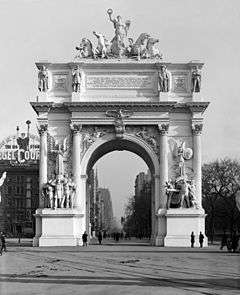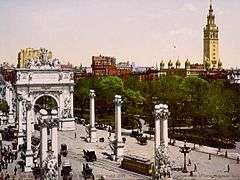Dewey Arch
The Dewey Arch was a triumphal arch that stood from 1899 to 1900 at Madison Square in Manhattan, New York.[2] [3] [4] It was erected for a parade in honor of Admiral George Dewey celebrating his victory at the Battle of Manila Bay in the Philippines in 1898.[5]
 The Dewey Arch as it appeared in 1900. | |
| Coordinates | 40°44.53′0″N 73°59.34′0″W |
|---|---|
| Location | New York, New York |
| Designer | Charles R. Lamb |
| Type | Triumphal arch |
| Material | Staff [1] |
| Length | 70 feet (21 m) |
| Width | 30 feet (9.1 m) |
| Height | 85 feet (26 m) |
| Opening date | September 1899 |
| Dedicated to | George Dewey |
 | |
| External video | |
|---|---|
Planning for the parade, scheduled for September 1899, began in the spring of that year. The architect Charles R. Lamb built support for a triumphal arch among his fellow members of the National Sculpture Society.[6] A committee of society members, including Lamb, Karl Bitter, Frederick W. Ruckstull, John Quincy Adams Ward and John De Witt Warner,[7] submitted a proposal for an arch to the City of New York, which approved the plan in July 1899.
With only two months remaining before the parade, the committee decided to build the arch and its colonnade out of staff, a plaster-based material used previously for temporary buildings at several World's Fairs. Modeled after the Arch of Titus in Rome,[5][7] the Dewey Arch was decorated with the works of twenty-eight sculptors and topped by a large quadriga (modeled by Ward)[7] depicting four horses drawing a ship. The arch was illuminated at night with electric light bulbs.[8]
After the parade on September 30, 1899, the arch began to deteriorate. An attempt to raise money to rebuild it in stone (as had been done for the arch in Washington Square Park) failed, owing to the growing unpopularity of the Philippine War. The arch was demolished in 1900,[4] and the larger sculptures sent to Charleston for an exhibit, after which they were either destroyed or lost.[5]
See also
- Not to be confused with the Victory Arch which was built in the same place in 1918 and torn down 1920
Notes and references
Notes
- Brody 2010, p. 133.
- Architects' and Builders' Magazine 1900, p. 1.
- Cusack 2005.
- The New York Times 1900, p. 16.
- Gray 1992, p. 7.
- Lamb 2020.
- Sharp 1985, p. 52f.
- Nye 1992, p. 51.
References
| Wikimedia Commons has media related to Dewey Arch. |
- Architects' and Builders' Magazine (1900). "The Dewey Arch". Architects' and Builders' Magazine. W.T. Comstock. vol. 32. ISSN 0749-3088. OCLC 8754926. Retrieved May 12, 2020.CS1 maint: ref=harv (link)
- Brody, David (2010). Visualizing American Empire: Orientalism and Imperialism in the Philippines. University of Chicago Press. ISBN 9780226075341.CS1 maint: ref=harv (link) - Total pages: 213
- Cusack, Andrew (January 19, 2005). "The Dewey Arch". andrewcusack.com. Retrieved May 12, 2020.CS1 maint: ref=harv (link)
- "Art and Artists - Destruction of Dewey Arch" (PDF). The New York Times. The New York Times Building, 620 Eighth Avenue, New York: Arthur Ochs Sulzberger Jr. December 30, 1900. ISSN 1553-8095. OCLC 1645522. Retrieved May 12, 2020.CS1 maint: location (link)
- Gray, Christopher (May 10, 1992). "Streetscapes: Monumental Parallels; The Arch and the Bandshell". The New York Times. The New York Times Building, 620 Eighth Avenue, New York: Arthur Ochs Sulzberger Jr. ISSN 1553-8095. OCLC 1645522. Retrieved May 11, 2020.CS1 maint: location (link) CS1 maint: ref=harv (link)
- Nye, David E. (1992). Electrifying America: Social Meanings of a New Technology, 1880-1940. MIT Press. ISBN 9780262640305.CS1 maint: ref=harv (link) - Total pages: 479
- Sharp, Lewis I (1985). John Quincey Adams Ward: Dean of American Sculpture. University of Delaware Press. ISBN 9780874132533.CS1 maint: ref=harv (link)
- Lamb, Charles Rollinson (2020). "Charles R. Lamb scrapbook on the Dewey Arch, 1899-1901". Smithsonian. Retrieved May 12, 2020.CS1 maint: ref=harv (link)